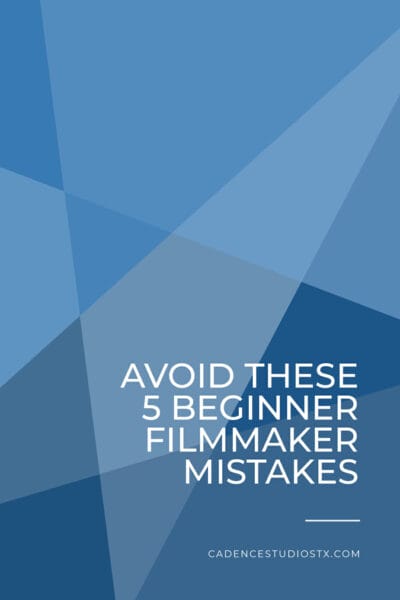Avoid These 5 Beginner Filmmaker Mistakes
When you’re learning a new skill, you make a lot of mistakes. Trust, us. We did! Luckily, we have learned a lot over the past years of working with different types of equipment, locations and talent. From the basic skills of learning how to hold a camera steady when you don’t have a gimbal to do it for you to going beyond just capturing film, here is a list of some of the mistakes we see a lot of beginner filmmakers making and how to overcome them.

Not Minimizing Camera Movement
One of the advantages film has over photography is movement. Movement has the ability to direct the viewer’s attention and show the audience what you want them to see and pay attention to.
You’re probably comfortable with setting up your tripod, attaching your camera and filming from there, and that is great for interviews and more static applications. The best videos require the camera to moving with the action that is being captured. The obvious way to do this is to take the camera off the tripod and hold it with your hands. But now you have to worry about how much camera shake you’re introducing to what you’re filming.
Here’s the secret to capturing movement without using additional tools: stick your arms in next to your sides and keep the camera next to your center of gravity. If you observe a professional photographer or videographer, you’ll almost always see them shooting with their arms tucked in tight to their body. This helps stabilize the camera and therefore the image being captured.
Ignoring the Importance of Sound
When working with video, having clean sound will make or break your project. This is one of the differences between video and photography, and it is what separates the student from the professional.
Better sound starts with a better mic. This is true for pretty much any audio application- DIY videos, podcasts, etc. Invest in a decent microphone. Do not rely on your camera’s audio to record the audio. You’ll thank us when you go to edit the video.
Overlooking Depth of Field
Depth of field is a very technical-sounding term, but don’t let that scare you off. It’s simple to understand and when used well, you can transform ordinary images into cinematic gold!
In it’s most basic terms, depth of field refers to the area of your image that’s in focus. In other words, you can use it to make blurry backgrounds and blurry foregrounds. It is a technique that is used to direct the viewer’s attention. When we strategically place things out of focus, the viewer doesn’t pay attention to them, they focus on the part of the image that’s in focus.
Being able to correctly use depth of field will make you a better filmmaker. Don’t make the beginner mistake of trying to get your images super-sharp and thinking that anything less is not usable.
More Coverage is More Better
Pardon our English, but this one important.
What is the thing that makes film different from a play? It’s the different perspectives and viewpoints you can create in the editing room! Different angels of a conversation, different views of the same room or even the same person are what truly make your final product interesting for your audience. So make sure you’re getting wide, close, mediums, and interesting shots to make your film stand out!
One of the most heartbreaking things that can happen to a newbie is not getting enough coverage of their scene. You want to be sure you’re getting these angles so it’s easier to cut in the editing room. We always say you can never have too much ‘B Roll.’
Just Filming
It’s really tempting for new filmmakers to concentrate soley on the visuals and forget the story they’re trying to tell. Having a story to tell is the main thing that separates beginners from pros. Have your story be visual and interesting! Use the medium of film to your advantage. A string of great visuals with music is a music video, but how can you tell a story with those visuals?
There are so many ‘pretty pictures’ now, the only thing that’s going to differentiate you from the rest is your ability to tell a story. Move your audience with your storytelling. Whether that’s moving to purchase, moving to vote, or decide, or to feel something, all of those things are great stories to tell!




